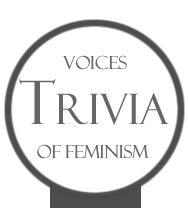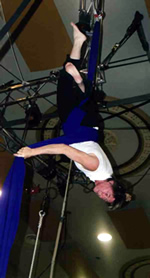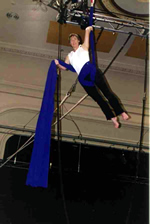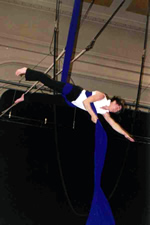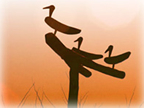The Aerial Lesbian Body:
the Politics of Physical Expression
Susan Hawthorne
The body
What does it mean to have a body? To be a body? To be embodied? Does the shape of a body change one’s experience of the world? Does the sex of a body affect one’s experiential base? Do the colour, the age, the infirmities, the sexualities and classes of experience have an effect on how we see ourselves and the world? These are all political questions. And yet, we are led to believe 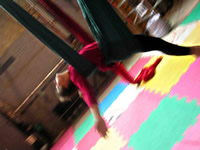 that our bodies are simply encasings and surfaces that journey across time and space without any political import.
that our bodies are simply encasings and surfaces that journey across time and space without any political import.
Let me speak of my body. It is female. It is white (so-called). These things are easy to spot. It is older than it looks. It is a lesbian body. Visible to those who know how to pick up the signs. It is sometimes a body afflicted with a disability. A disability that ranges from completely invisible to highly visible. It is a body changed by epilepsy. It is a body breaking silences, crying out for speech. It is also a body that has explored the experiences of other bodies. Bodies not my own.
The female body
They said I shouldn't live
You see, I'm a girl
My sister was not so lucky,
she died of preventable diarrhea
My sisters are many
but the living not so numerous as the dead
From Eye of a Needle, 2005
(Hawthorne, 2005a: 226)
The female body is the oldest form of symbolic representation in art. The body of the earth is our starting point. The female body is how we all begin. Ancient representations and stories show a deep trust in the body, in stark contrast to the experience of most women and girls on the planet today.
Adolescence takes young women away from their bodies. When sexuality appears, young women are told to hand their bodies over to men and to boyfriends at a time when they hardly know the possibilities. Our bodies are tamed and silenced. As an adolescent, I had little confidence in the possibilities of my body.
Marketing in the 1960s, and even more so now, suggests that we see our bodies not as our own, but as the plaything and even the property of another. It is a patriarchal tradition that the bodies of girls belong first to their fathers (and brothers and uncles) who then pass girls into the hands of a husband. Even when such traditions are not formalised, they are nevertheless followed. In late postmodern market economies, global companies, the medical and pharmaceutical industries and far too frequently the sex industries appropriate the bodies of girls and young women. These appropriators want young women to disengage from their bodies, to focus instead on ways of acquiring the fantasy body according to the desires of heterosexual discourse. In the “pornography of everyday life” (Caputi 2004: 74-116) the female body is decorated, fed, starved, dressed and undressed for the pleasure of men.
How are we to counter these ideologies of disengagement? How are we to claim our bodies for ourselves? What are the politics of physical expression? And how might we use physical expression as reclamation of our bodily integrity and as a way of creatively expressing engagement with the body?
As women, distrust in our bodies affects the way we move and it affects our souls, that inner life which arises from deep bodily experience. At fifty-five, were I to believe the media images, I should be almost ready to fold myself away in a protective cocoon of physical inactivity. 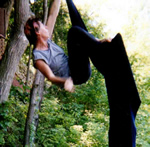 Instead, I have become an aerialist, a solo aerialist who is constantly learning the power and strength of the aging female body. I've been an active person throughout my life, but I have never been as strong, as centered and as trusting of my body as I am now.
Instead, I have become an aerialist, a solo aerialist who is constantly learning the power and strength of the aging female body. I've been an active person throughout my life, but I have never been as strong, as centered and as trusting of my body as I am now.
I began circus training at age forty-three. Thirteen years later, I am stronger and I trust my body in ways I could not have imagined thirty years ago.
Among the meanings of aerial is “imaginary, visionary” (Collins Australian Dictionary). As an aerialist, I bring to the work an imaginary idea of how my body might be, how it can change, how it can even fly.
My mother always wanted to be a bird. She could whistle symphonies and she dreamt of flying. Instead, she married a pilot.
From Lilith (1999)
Flight. I often dream of flying. No wings needed, soaring above the earth, swooping like an eagle. A great sense of freedom. From aerials I have learnt to grasp that freedom, to believe that I can do whatever I set out to do – within my physical limitations.
What I have learned from aerials is how to release that body, how to express deeply felt emotion, how to use my body to speak. As a woman, this is challenging. When I speak simply as a woman, I am read as heterosexual, as a challenge to heterosexual norms which demand that women wear crippling shoes, aim for skimpy tops that reveal unmuscled arms, which insist that any muscles that are there are simply for tone and good looks, not for strength.
Within that context of heterosexual discourse, a woman who engages in circus should be petite, dressed in frills, and perform delicate acts that disguise her strength rather than show it.
But the circuses I joined resisted these notions of femininity. Developing trust was a key element of our training. At first, I saw myself as a flier and incapable of basing. Others saw themselves in the opposite way, that is, they could not trust another woman to hold them up. As my strength and confidence grew, I learned also to base. As the confidence and trust of those who started as bases grew, they learned to allow another woman to hold their weight.
The lesbian body
we meet in the gymnasium not to huff and puff and sweat into wet towels this is a gymnasium for women it takes into account all the needs of the body the mind the wild spirit
here lesbians read Sappho in her original tongue we converse and share our memories of families of ancestors without issue we compare family trees where a single woman sits alone on a branch she is on the topmost bough with the reddest apple in her hand she is about to take the first bite the final bite perhaps she will be cast off this bough not allowed to inhabit the ordinary society of people
From Unstopped Mouths, 1997 (Hawthorne 2005a: 11)
The silence around lesbian culture reflects the silence around lesbian existence. The deniability of both keeps them at a safe distance.
Performing the lesbian body is a different challenge from performing the unmarked heterosexual female body. Challenging the female body can be as simple as refusing to be weak or helpless or silent. Gaining strength, physical control through being centred in one’s bodily possibilities is sufficient. But what does it mean to perform the lesbian body?
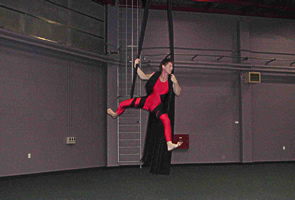
The stereotype of the lesbian body as “butch,” that is, strong in a masculine kind of way, is such a mainstream image that strength alone is not sufficient to challenge ideas about lesbian bodies. In performance, the audience overlays intention with interpretation, so when performing the lesbian body, I like to surprise by combining strength and grace, toughness and vulnerability, to create space for the whole range of possibilities.
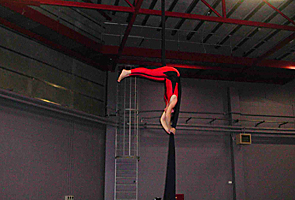
As a radical feminist lesbian, I come to aerials and circus performance with a belief in the strength of women. I feel comfortable with the touch of women. I enjoy lying across the body of a woman or having a woman’s body pressed up against my own. I have observed some (not all) heterosexual women approach such intimacy with caution.
I have seen many sexual relationships blossom from partnering in circus. Imagine two bodies moving in synchrony, one giving her entire body in trust to another. One taking on the well being and safety of another’s body. Imagine the engagement of hands, belly, feet, back, shoulders, hips, groin, neck. Imagine leaving out the heart?
As in every other human endeavour, there are boundaries crossed and uncrossed.
I know that my level of engagement is heightened when I work with another lesbian. It is this intensity of emotion, of total trust and care that makes the difference.
As a flier, I have learned to care for my base. Until I learned to base others, I was careless. It is the dance of sameness and difference that matters here.
In mainstream circus, non-lesbian women throw their weight around because they know that the man – even if he’s imaginary – will catch them. After all, he is big and strong, stronger than her (at least this is the myth). Sex and sexuality are played out as usual: large male base, petite female flyer. A lesbian knows that the body who catches her is the same as hers, has all the same vulnerabilities. So, it makes sense to land in the best way possible.
When two women care for how their bodies impinge on each other, it changes their bodies. Eye contact amplifies the connection. The caress as two hands meet in preparation for a flag, or for a double aerials routine, is visible throughout the entire double body.
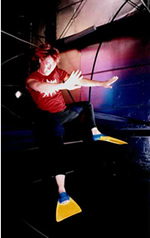 What I have learned is that every other element is also my partner. The floor, the trapeze bar, the space between the two, and especially the material body of tissu. Through tissu, I have learned that the same engagement I have with another woman can be transferred creatively to the space and the gear with which I work.
What I have learned is that every other element is also my partner. The floor, the trapeze bar, the space between the two, and especially the material body of tissu. Through tissu, I have learned that the same engagement I have with another woman can be transferred creatively to the space and the gear with which I work.
As a solo performer working with text and tissu, both my voice and my body carry my expressiveness. This is perhaps, in part, an effect of my age. Age can bring confidence as well as the possibility of deeper emotional resources. With age has come a greater understanding of strengths, weaknesses and of the meanings held in the expressive body. I can convey emotion with my eyes or with the flesh. I can look at an audience with impunity, with joy or simply an open questioning.
The aging body
You’re too old to join a circus
You’ll make a fool of yourself
You’re too old to have fun
You can’t teach an old woman new tricks
Act your age
From Act Your Age, 1995
As we age, we no longer fit the mould of thin, lithe, unwrinkled beauty. It’s not to say we lack beauty, far from it, but the measure is different.
At forty-three, I thought I was fit. At fifty-five I know I am. I can do a twenty-minute performance and feel energised by it. Five minutes would have been past my limit eleven years ago. I can do a better handstand than at any other time of my life, although it is still a work-in-progress.
I cannot bend my back into a backbend any longer, and one knee or the other gives me pain if I sit with it bent for too long. I cannot run as far or as fast as I used to be able. I can feel the aging process, but against this process is another which involves building strength and endurance.
My self-esteem is no longer damaged when I simply cannot hold on. It’s about balancing reality with ambition. And there are days, sometimes even weeks, when I simply don’t have the energy to practice, or even play.
I sometimes think of Valerie Solanas and her “uppity, thrill-seeking females.” It could describe most of us who have joined a circus. I am a risk-taker and I take life in both hands. With age, I am still fearless, but more protective of my safety. I learn more methodically and will pursue a course longer, knowing that persistence usually works. In doing this, I have learned tricks I thought were out of my reach: most recently, a foot hang which I’ve admired others doing for years. Just this week after months of trying I managed it—not only that, every woman in the class this week managed it. I have never seen that happen before. I think of the hundredth monkey, of the “hundredth lezzie,” 1 and it sustains my belief that enormous change is possible.
I enjoy improvisation. The uncertainty reminds me of the leap of faith I take each time I sit down to a blank page. There is an attentiveness to present conditions that escapes us most of the time. How will I respond to this phrase of music? How will I bend to this body? How can I move from this position to the next?
Improvisation enables you to explore the metaxu, the spaces between, the transitions. It is not about goal setting, but rather about experience.
Cyclone 12
Half way through this essay, I go through a Category-5 Cyclone. Cyclone Larry hits the coast of far north Queensland on 20 March 2006. It is the same intensity as Katrina. We lie awake waiting for the winds to reach their peak. The power goes off at 3 a.m. We watch the trees dancing and shaking. We listen to the increasing roar, howl and whistle of the wind. At 6 a.m. we take cover in the bathroom, and as the sky lightens, the wind reaches a terrifying intensity. Everything is grey. The heliconia leaves have been shredded. They are like skeletons. Behind us, the winds go into reverse. Trees snap. Rooves lift. The guttering and down pipes drop away.
As we emerge into the wreckage of daylight, we stand in stunned silence. Around us, the rainforest too has been silenced. There are no early morning birdcalls. The tree beside the garage has fallen, is uprooted. We try to walk down the driveway, stepping across fallen trees. Green ants’ nests litter the ground, and we jump at the multiple bites.
As the days pass, we collapse from exhaustion. We sweep, we collect, we mop up, we gather everything in the sun to dry – and then it rains. We mop up yet again. Each morning we wake more exhausted from cyclone dreams. The roar of nature has somehow entered our bodies. It has rattled us more than we thought.
It is two more months before I can begin writing again.
The thing about epilepsy is that most of the time you can pass as unafflicted by anything. But when the grand mal attack comes, there is no hiding from it except in unconsciousness. It is a “disability” that is paradoxically both invisible and highly visible.3 I used the theme of epilepsy in my first solo performance in which I explored the matrix of language, myth and the experience of falling.4
There's a language in my body too
A language in the arch of my back
A language in the froth from my mouth
A language in my clenched fist
A language in the cry from my lungs
There's a language in my bleeding tongue
From The Language in My Tongue, 1999 (Hawthorne 1999a: 53)
Throughout my life I have taken risks, risks that some would consider unacceptable. I have lied in order to scuba dive, and I have persisted with aerials in spite of the occasional question about whether it is safe for me. In both cases, I am virtually uninsurable. My risk is seen as unacceptably high.
Climbing a tissu, moving through different shapes on a cloud swing, does not lead one into a state of relaxation. It is, perhaps, more like meditation, a way of having time out from the mental hassles of the day. It has a remarkable ability to shift a migraine. But when you are hanging off a trapeze you are there in the moment with your whole being.
My relationship to the concept of falling has changed through practicing falls in circus. I can fall straight and not hurt myself. This technique – known as Streb – is shocking when you first try it, but as you do it again and again, the body adapts, as it does in martial arts, to the impact. I can fall from stilts. Fear is the biggest block to doing this. Allowing the body to plunge forward several feet is both terrifying (at first) and exhilarating (later).
In aerials there are all kinds of falls and drops and slides. They are all frightening at first. But as with Streb and stilts, after repeating it over and over time slows, the body rolls, spins, slides, drops, plunges towards the ground. Perhaps someone will say I’m addicted to the adrenaline rush. It’s possible. But it is more than that, it’s about learning one’s limits. It’s about knowing what you are afraid of and what you are fearless about.
In my early twenties, I did a fear test in a physical education class. Most things didn’t scare me, at least not until I had to walk along a shaky beam into a space with nothing to hold on to. In aerials, I have hit the wall, metaphorically, only a couple of times. The first slide I learnt on trapeze was from back hang to ankles. The first three times, I screamed. The next – a performance – I restrained the scream. After that, I did it over and over. The next fear-filled experience was when I was doing an intensive class in flying trapeze. There was a moment – I can still feel the terror – between grasping the bar in my hand and having to release so that I would land on my feet. Time expanded. It seemed to go forever. And as I landed, the tears were unstoppable. But like the bicycle or horse you fall off, you must get on again. And so I did.
There have been other days of fearfulness. Other new moves that scared me. I have leapt each hurdle, sometimes wondering what I was doing.
I have used the experience of epilepsy in scripts and performances. The Performing Older Women’s Circus (POW)5 show, The Art of Falling is Never Landing (2000) was commissioned as part of a Falls Prevention Program in the local community. We interviewed older women about falling, and in each case the physical fall and the emotional fall coincided. Sometimes it was about the body needing to rest, sometimes an emotional collapse was followed by a fall. We played on this, providing a moment of audience terror as one performer intentionally falls while walking in stilts. I know from my experience of epilepsy that seizures, emotional stress and wanting a means of release are connected, but these interviews and the subsequent show intensified that understanding.
The disabled body
I lifted the wheelchair out of the boot of the little red car wondering how we'd get it down the slope to the water. My aunt grabbed the chair and tumbled Clare into it. We slithered down the path and then my aunt started to run down to the beach, the wheelchair hurtling before her. Clare had her arms up to the air and was laughing and shrieking. I was terrified. Not stopping to lock the car, I ploughed after them. I caught up with the wild women at the water's edge.
From The Maiden Aunt’s Story, 2002
When the Gay Games came to Sydney in 2002, POW toured a new show that focused on the hidden lesbian lives of maiden aunts. The central narrative concerned an aunt and her partner of forty years which was based on the story of a member of POW.
The above sequence was performed using a wheelchair, lifting and double balances. It was an extraordinarily beautiful piece of theatre. The woman who played Clare did not use her legs at all and the two women moved like seawater. It was both fluid and strong.
In another performance, Power Moves (2001), two adagio pairs used zimmer frames to move in and out of balances. As the body muscles strengthen it is possible to move in other ways, using hands, using the strength of another woman in lifts, using backs, thighs and other large muscles. I was one of these pairs and at first I thought it would be too hard to develop a routine, but we persisted. We played and experimented, using both the zimmer frame and our bodies, inventing new ways to move across, through and over.
It is possible to use aerials gear in a similar way. To melt up out of the ground into the air through fluid dance-like moves that challenge the muscularity of aerials and yet simultaneously require great muscle control.
Circus, for those of us who have never trained professionally, is about the art of the possible. In using this term I am reminded of Jane Caputi’s article, “Cunctipotence: Elemental Female Potency” (2006) in which she highlights the use of the word “possible” in slave narratives as a word for cunt. She draws out the connections with potency and potential and reminds us that one of the definitions of possibility in Webster’s is “one’s utmost power.6
Actualizing cunctipotence means staying in tune and time with the elemental energies, not solely taking from but also giving back to that Source, being alert to Chance, falling in with Fortune, listening to the voices of the elemental world, and acting with integrity, when opportunity presents itself for influence. In so being and doing, we can use this, our utmost power, to shape Change so that good things happen. We can even call other worlds or realities into being. (Caputi 2006).
Doing aerials is about potential, about possibilities, about actualizing other worlds in which the movement of a woman’s body is an expression of bodily integrity. As a lesbian, I value my freedom of movement and want to claim that art of the possible with all its resonances of meaning. As a person whose body is considered uncontrollable in epileptic seizure, creating a world in which I can subvert that message by falling, by unexpectedly dropping on the tissu, is a defiant act.
The speechless body
Speechlessness is an attribute of oppression. Silence slips between us. (Hawthorne 2007b). Sometimes we simply do not speak. Is it fear? Is it because we do not wish to make ourselves visible? As a person with epilepsy, I was silent for years. So much so that when I first began to write about my experience, I began to tell a tale of autism.
As a lesbian, I am sometimes silent. But the metaphor of the mouth, of tongue and lips, is so central to lesbian experience, that in the end, I must speak.7
Many women have endured silence. Displaced women have lived in silence. Indigenous women punished for speaking their own languages have endured public silence. Lesbians have lived through layers of silences. Poverty and violence create silence. Disability, age and chronic illness are met with institutionalised silence.
Speechlessness is common to so many women struggling to find ways to live.
Through writing and circus, I have found ways to engage in speech.
In early 2000, I left the Women’s Circus in the midst of an argument over whether transsexuals should be admitted. This was a circus established to work with women who were survivors of sexual assault. I could not reconcile the two positions and the circus lost several members that year. It was a huge loss for me, and in my loss, I began to play on my aerials gear at home. I began to write of that loss.
Today the sadness envelops her,
her loss, not a lover but a way of life,
like the shrivelled skins of old apples
which have lost their elasticity
her mood drops like leadGravity’s rainbow could not fold
into the fall of her hair, nor its gold
be worth anything on the stock exchange
From Gravity Defied, 2001 (Hawthorne 2005a: 213-4)
The process of writing, improvising, writing again developed into a way of speaking.
The focus, the physical work, the concentration on putting these two art forms together gave me an enormous sense of well being.
She said, I defied them
I have a friend, a poetWho can read Greek
In secret I learned from herIt helped her unravel the birdsong
She heard them as they sangwitness to her Victorian violations
Their song the same as on the daywhen Persephone was raped
and Zeus couldn’t care less
From Greek, 2004 (Hawthorne 2005a: 217-8)
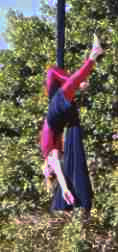 Greek (2005) explores the effect of violation on language. It shows the speechlessness that results from being the victim of attack.The sense of betrayal I experienced when, after speaking out my discomfort at male bodies coming into this female space, I was ostracized. I heard one woman say “She has a history of that”—i.e. of speaking out and causing division. When women speak out, about rape, about violation of any kind, dismissal and slur are common.
Greek (2005) explores the effect of violation on language. It shows the speechlessness that results from being the victim of attack.The sense of betrayal I experienced when, after speaking out my discomfort at male bodies coming into this female space, I was ostracized. I heard one woman say “She has a history of that”—i.e. of speaking out and causing division. When women speak out, about rape, about violation of any kind, dismissal and slur are common.
The inability of women’s groups to deal with political differences creates speechlessness. In this case, the entire organization was silenced, and in my decision to leave in protest, I too was silenced. I rejoined in 2001 in order to be part of the annual show that year entitled Secrets, a show about silence in the face of sexual violence against girls and women.
Cyclone 2
The seasons have turned once again and the wet season is upon us. I recall the sense I had in the immediate aftermath of the Cyclone:
the clock moves in one
time space, our bodiesin another, one day by
the clock, years by ourbodies the world of faery
dumped on our heads
From Cyclone Dreams, 2007a
There was the mix of adrenaline and exhaustion not too dissimilar from how the body feels when preparing for a performance. But more than that, the experience of the cyclone was also about the body of the earth, the earth as body. I find myself in the midst of poems about the skeletons of trees, the bones, the spine, the vertebrae. There were times during the cyclone when I felt a strange kind of “cosmic acceptance” of all that was going on around me. I was more fascinated than fearful.
In the human world there is always a perpetrator.
The tortured body
In 2003, I developed first a scene for a group show, and then a solo performance on the theme of the torture of lesbians. This was prior to the scandal around Abu Ghraib and the public discussion about torture. It followed from three overlapping revelations of lesbians confronting torture. The first was that of a friend who told me of her experience in a South American jail in the 1970s; another was that of a Ugandan lesbian who warned that I should speak carefully while in Uganda, since lesbians had been tortured; the third was reading Consuelo Rivera Fuentes’ writing about her experience in Chile in the 1970s. I felt a need to tell these stories.8
In developing this work, I was greatly influenced by Elaine Scarry’s The Body in Pain: The Making and Unmaking of the World, a dense and insightful book. My copy is now filled with underlinings, with comments, with the beginnings of essays or poems. Elaine Scarry’s approach is a bit like the poet’s. She writes a sentence and over the next several pages unpacks the sentence, teases out all the possible threads of meaning. She engages with the hypothesis that “Pain does not simply resist language but actively destroys it.” (1985: p. 4).
How long is a day?
They arrested us just before dawn.
Pulled from our narrow bed.
There was terror and a tearing
as if the body were separating from itself.
Animal House, 2003 (Hawthorne 2005a: 215)
In the first version of this show, I had to execute a drop. Using tissu wrapped around the body several times, from a position in which I am perched above the cloth, I release my hold. The body spins, rolls, turns until reaching its final position upside down two metres above the floor.
By the end of this drop, I am experiencing something inside the text: a sense that the body is separating from itself. Yet in the repetition of rehearsal and performance that tendency to dissociation is decreased. Indeed, in a way it is resisted through the development, through my body, of my utmost power.
What interests me is the way in which the body, through this experience, conveys meaning to me. Performance, especially physical theatre, embodies this exchange between the performers through the muscles, through the electrical responses of the body. While the drop I do is sometimes scary, it is certainly not torture. Nevertheless, through the ritual repetition of the drop in performance, I have grown in my understanding of what torture means. The experience of being so thoroughly in the moment is a way to understanding—in the same way that the experience of the cyclone simultaneously takes one out of the body and roots one so completely in it. That connection is the total harmony and concentration of both body and mind.
In Iran, new bicycles have been designed for women so that their body movements are not exposed when riding. “The clergy considers women’s body movements made while riding a bicycle to be provocative.9 Like these restrictions, like high heel shoes, like heterosexualised weakness, the purpose of torture is to break a person, to break a woman, to break a lesbian. It is to disorient, weaken, disallow joyful movement for its own sake. It is to destroy language and render us speechless.10
The purpose of feminist circus is to do the opposite. It is to create the art of the possible. It is to create the possibility of very different kinds of bodies, bodies that subvert and disrupt in the best feminist tradition you can think of. It is a process of engagement with the body; of increasing awareness of orientation – vertical, horizontal, inverted and anything in between. It is a process that is inventive and creative, one in which bodies and words speak out.
In circus – as in the cyclone – I have found moments which reverse the methods of violence we find so often in our society. Instead of being broken and disoriented, in those moments, I am somehow complete.
The singing body
One has the imagination of one’s century, one’s culture, one’s generation, one’s particular social class, one’s decade, and the imagination of what one reads, but above all one has the imagination of one’s body and of the sex who inhabits it.
Nicole Brossard. 1988, The Aerial Letter. p. 82.
The body is never far away in creating knowledge about ourselves and about the world. During childhood (with luck), the body is forever tested. We crawl, we wobble, we half stand, we fall, we stagger, we walk, we run. In the case of speech, we gurgle and burble, we make funny sounds, imitate words, create sentences on our way to full-blown talk. Imagine learning any of this if each day we were told we couldn’t or shouldn’t. As we grow into our bodies and our languages, many of us are restricted. Some of us rebel. For some the body and mind are torn apart. The intent of patriarchal socialization is to tear that fabric.
In bringing together text and aerials, I have resisted this tearing of the body from the mind: a tearing that rends the soul. We women do not need more betrayal of ourselves, whether we engage in such activity apparently “willingly” or whether we do it because we know little about how we might resist the destruction of our cultures – our lesbian cultures as well as the rich cultures passed down from grandmother to granddaughter, mother to daughter, aunt to niece. As I lament in my performance piece, Greek:
if only she could go some place quiet
be looked after, listen to the birdsunderstand their speech
unstop her ears
From Greek, 2004 (Hawthorne 2005a: 216)
Through aerials I have learned to listen to my body. I have learned also, to listen to the bodies of others, to the tissu and the trapeze. I have become volatile, aerial and imaginary. I have learned to sing my body into being.
Coda
As I send these reflections out into the world, I am still pondering the psychic and physical effects of a Category 5 cyclone. The intensity of my response through recurring dreams of violence, physical exhaustion and subsequently low-level depression surprised me. I am a high-energy person, and I felt as if I had experienced psychic whiplash. I was so pleased to see the end of 2006.
In early 2007, I attended a ten-day Circus Festival which gave me the chance to spend six hours a day doing aerials. I enrolled in a swinging trapeze class. Trapeze is simultaneously scary and exhilarating. In this class, I was taken to two places in moves that I’d never anticipated attempting. The first is a move which – in terms of the fear quotient—resembles jumping off a cliff, or dropping like an eagle. It seems impossible: dropping arrow-like from standing on the trapeze to catching the bar at the back of the swing.
I overcome the fear, and drop. I don't do it very well, but I do it. Then, in a move that is difficult at first, I am moving between sitting and standing on the bar. I lift, almost a bounce, from sitting to standing and without warning comes a sense of weightlessness. In that moment I am child, I am bird, I am a woman in flight and everything is in tune. The exhilaration lasts for days. I have bounced out of the eye of the cyclone, out of depression (climactic and personal) into a new year in which I can practice the art of the possible.
------------------------------------------------------------
The following images are taken from the POW performance, Something Old, Something New (2003).
When I began to prepare for the performance, I did not anticipate the way in which I would begin to feel the pain in my body. The performance is quite rigorous, involving tissu, a long piece of cloth which is hung from the aerial rig.
The wrap The cloth is wrapped and wound about the body. It requires considerable upper body strength and a certain amount of agility. |
Perched above the tissu The final part of the performance is a double drop. In the drop, I wrap the tissu first around my upper thigh, then around my waist and pull myself up so that I am perched above the tissu. I am about four to five metres above the floor. |
Halfway through the drop I release one hand and as I drop, my body twists and turns according to its wrap. |
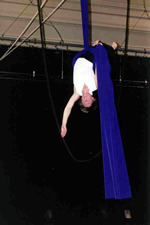
At the end of the drop, I am two to three metres above the floor. |
Notes
- In “The Hundredth Lezzie,” which appeared in Trivia 6, Tremor applies the hundredth-monkey theory to lesbian evolution: “If enough of us—one by one or in odd, queer numbers—risk enchanting wildly, audaciously, lesbianly, heretofore obscured possibilities will emerge. . . One bold woman makes more of the same possible, one strayer can lead to a baker’s dozen, hundreds of indomitable lesbians freed from patriarchal lies can jump across islands. . .” Trivia 6, Winter 1985,pp. 33-37. (back to article)
- Cyclone is the word used for hurricane or typhoon. A Category 5 cyclone has winds of at least 290 kph (180 mph). Cyclone Larry’s winds reached at least 300kph. (back to article)
- I write about this in “From Theories of Indifference to a Wild Politics.” 1996. (back to article)
- I have also written about my experience of epilepsy in my novel, The Falling Woman (1992) and in a collection of poems, Bird (1999). (back to article)
- The Women’s Circus was set up in 1991 to work with women survivors of sexual abuse. The founding Artistic Director, Donna Jackson, wanted to provide women with ways of expressing bodily trust (Liebmann et al, 1997). It was clear to her that in order to achieve her goal it would have to be an all-women circus. Melbourne, like Montreal, is home to many circuses: Circus Oz has its home in Port Melbourne; there had been a group called Wimmin’s Circus in the late 1970s, The Fruit Flies had begun in rural Victoria and there was a thriving history of traditional circus. In 1994, the Women’s Circus put out a call for older women to join and so I put my name on the waiting list. Just as the time came to go along to my first class, another group, which became the Performing Older Women’s Circus (POW), was called into being. Its mission was to show what older women could do and to foster lesbian visibility. When I first said I wanted to learn trapeze, the founder Jean Taylor was a bit surprised, but my wish found an echo with others. For more on the Performing Older Women’s Circus see Hawthorne 2005b and 1999b. (back to article)
- Possibilities: Jane Caputi (2006) has given me a new sense of the meaning of the term possibility. (back to article)
- This was the spark that led to me writing “Unstopped Mouths” (2005). (back to article)
- See Rivera Fuentes and Burke (2001). My research led me to write “Ancient Hatred” (2006). (back to article)
- “Iran covers bike women.” The Weekend Australian, May 19-20 2007. p. 13. (back to article)
- The women in That Inferno (Actis et al 2006) affirm the impact of torture not only on the body, but also on a woman’s sense of reality and her ability to speak of her experience. The other element that struck me from their testimonies was the “acts of social hetersosexuality” that the women in this Argentine torture camp were put through. (back to article
References
- Actis, Munú, Cristinia Aldini, Liliana Gardella, Miriam Lewin, Elisa Tokar. 2006. That Inferno: Conversations of Five Women Survivors of the Argentine Torture Camp. Translated by Gretta Siebentritt. Nashville: Vanderbilt University Press.
- Brossard, Nicole. 1988. The Aerial Letter. Toronto: Women’s Press.
- Caputi, Jane. 2004. “The Pornography of Everyday Life”. In Goddesses and Monsters: Women, Myth, Power and Popular Culture. Madison: University of Wisconsin/Popular Press: 74-117.
- –. 2006. “Cunctipotence: Elemental Female Potency”. Trivia: Voices of Feminism, Issue 4
- Collins Australian Dictionary. 2003 Sydney: HarperCollins.
- Hawthorne, Susan. 1992/2003. The Falling Woman. Melbourne: Spinifex Press.
- –. 1996. From Theories of Indifference to a Wild Politics. In Radically Speaking: Feminism Reclaimed. Diane Bell and Renate Klein (Eds.) London: Zed Press; Melbourne: Spinifex Press.
- –. 1999a. Bird and Other Writings on Epilepsy. Melbourne: Spinifex Press.
- –. 1999b. Cyborgs, Virtual Bodies and Organic Bodies: Theoretical Feminist Responses. In CyberFeminism: Connectivity, Critique and Creativity. Susan Hawthorne and Renate Klein (Eds.) Melbourne: Spinifex Press.
- –. 2005a. The Butterfly Effect. Melbourne: Spinifex Press.
- –. 2005b. Australia’s Performing Older Women’s Circus. In Casting Gender: Women and Performance in Intercultural Contexts. Lara Lengel and John T Warren (Eds.). London: Peter Lang Publishing. 67-83.
- –. 2006a. Ancient Hatred and Its Contemporary Manifestations: The Torture of lesbians. The Journal of Hate Studies. Vol. 4. 33-58. Online at http://guweb2.gonzaga.edu/againsthate/Journal4/04AncientHatred.pdf
- –. 2007a. Cyclone Dreams. Unpublished manuscript.
- –. 2007b. The Silences Between: Are Lesbians Irrelevant? Journal of International Women’s Studies. Vol. 8, No. 3: 125-138. Women’s Bodies, Gender Analysis, and Feminist Politics at the Fórum Social Mundial. Online at http://www.bridgew.edu/SoAS/jiws/April07/Hawthorne1.pdf
- Liebmann, Adrienne, et al. 1997. Women’s Circus: Leaping Off the Edge. Melbourne: Spinifex Press.
- Rivera-Fuentes, Consuelo and Lynda Birke. 2001. “Talking With/In Pain: Reflections on Bodies Under Torture”. Women’s Studies International Forum. Vol. 24, No. 6, 653-668.
- Scarry. Elaine. 1985. The Body in Pain: The Making and Unmaking of the World. Oxford: Oxford University Press.
- Tremor. 1985. “The Hundredth Lezzie,” Trivia 6, Winter 1985. 33-37.
Performance scripts
Performance scripts written by Susan Hawthorne, performed by Susan Hawthorne. The following texts are included in The Butterfly Effect:
- 2005. The Eye of a Needle. Plenary performance. International Women’s Health Conference, New Delhi, India. September.
- 2004. Greek. Private performance with Gayle McPherson in conjunction with art exhibition of works by Suzanne Bellamy. 22 May.
- 2003. Animal House. Massey University Events Centre, Palmerston North, New Zealand, 22 November.
- 2002. Gravity Defied. Solo performance and script. Directed by Mandy Pickett. Performed at Byron Bay Writers Festival 4 August.
- Second season performance: Gay Games, Newtown New Works, New Theatre, King Street, Newtown, Sydney 4-5 November.
The following text is included in Bird and other writings on epilepsy (1999):
- 1999: The Language in my tongue. Poetry and aerials performance. National Gallery of Victoria. The Great Hall. Performance associated with SEIZE Exhibition. Vic Health Access Gallery. Curated for the Epilepsy Foundation. Melbourne. 18 April.
Performance scripts, written by Susan Hawthorne, directed by Jean Taylor, performed by POW:
- 1995. Act Your Age. Text for Performing Older Women’s Circus Performance, 8-9 March. Pit Theatre. Footscray Community Arts Centre.
- 1997. Unstopped Mouths, script for Performing Older Women’s Circus Performance, 30 Oct-1 Nov. Pit Theatre. Footscray Community Arts Centre. Text included in The Butterfly Effect.
Performance scripts, written by Susan Hawthorne, directed by Kim Baston, performed by POW. Unpublished texts:
- 2001. Power Moves. Performed at PIT Theatre, Footscray Community Arts Centre, 27 September – 5 October.
- 2002. The Maiden Aunt’s Story. Performed North Melbourne Town Hall, 26 July to 3 August.
- Second season performance: Masters Games, Cromwell Road Theatre, Toorak. 8-12 October.
- Third season performance: Gay Games, Paddington Town Hall, Sydney. 6-7 November.
Weblink: http://www.spinifexpress.com.au
about the author
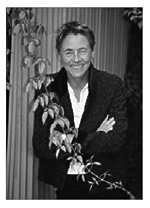 Susan Hawthorne is a poet, novelist, academic, activist and circus performer. Her books include poetry, The Butterfly Effect (2005) and Bird (1999), a novel, The Falling Women (1992/2003) and Wild Politics: Feminism, Globalisation and Bio/diversity (2002) based on her PhD. She has also edited numerous anthologies, the latest of which are September 11, 2001: Feminist Perspectives (2002, co-edited with Bronwyn Winter) and HorseDreams: The Meaning of Horses in Women’s Lives (2004, co-edited with Jan Fook and Renate Klein). She is co-founder with Renate Klein of Spinifex Press and a Research Associate in the Department of Communication, Culture and Languages at Victoria University, Melbourne. She has been published in literary, feminist and academic journals including Sinister Wisdom, Rain and Thunder, Ms Magazine, Off Our Backs, Tessera, Signs, WSIF, Canadian Women’s Studies and many others.
Susan Hawthorne is a poet, novelist, academic, activist and circus performer. Her books include poetry, The Butterfly Effect (2005) and Bird (1999), a novel, The Falling Women (1992/2003) and Wild Politics: Feminism, Globalisation and Bio/diversity (2002) based on her PhD. She has also edited numerous anthologies, the latest of which are September 11, 2001: Feminist Perspectives (2002, co-edited with Bronwyn Winter) and HorseDreams: The Meaning of Horses in Women’s Lives (2004, co-edited with Jan Fook and Renate Klein). She is co-founder with Renate Klein of Spinifex Press and a Research Associate in the Department of Communication, Culture and Languages at Victoria University, Melbourne. She has been published in literary, feminist and academic journals including Sinister Wisdom, Rain and Thunder, Ms Magazine, Off Our Backs, Tessera, Signs, WSIF, Canadian Women’s Studies and many others.
